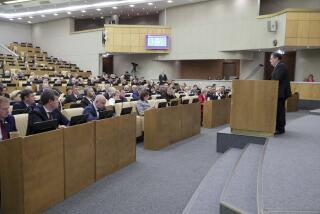Japan Approves Plan for Expanded Military Budget
- Share via
TOKYO — The Japanese government, under pressure from the United States to strengthen its defense capabilities, today approved a controversial defense plan that is likely to exceed a long-observed ceiling on military spending.
The $76.5-billion plan for 1986-1990 calls for an annual increase of 7.9% in defense spending, compared to growth in the 6% range over the last three years.
The new military budget amounts to roughly 1.04% of current projections for the nation’s gross national product for the five-year period, although a policy set in 1976 limits yearly defense spending to 1% of the GNP.
Aiming for 1% Ceiling
Foreign Minister Shintaro Abe said the new spending plan would not necessarily exceed the 1% ceiling.
“It depends on what the GNP will be,” he said. “We will try to respect the 1% ceiling.”
The Japanese government has been restrained in raising defense spending by strong anti-military sentiments in the nation since the end of World War II, a constitutional ban on maintaining an offensive capability and Finance Ministry attempts to stem budget deficits.
The United States, which has stationed 51,000 troops in Japan and is committed to defending the country from attack, has repeatedly urged the government to upgrade its air and sea defenses.
Abe told reporters that the five-year plan was “implemented with consideration of U.S. dissatisfaction with the 1% issue.” He said he had not received any reaction from the United States to the decision, but predicted that “the United States will commend our efforts.”
Prime Minister Yasuhiro Nakasone said the government had worked hard to meet U.S. requests.
“We have done our utmost,” he said after the military spending plan was formally approved at an unusual Cabinet session.
The 1% ceiling, which has become a symbolic figure for limiting military buildups, was adopted as part of defense guidelines set in 1976. The guidelines also called for Japan to develop the capability of repulsing a “limited, small-scale” foreign attack, and defense officials have said the new plan is intended to complete that goal.
Opposition parties immediately denounced approval of the new plan.
The Japan Socialist Party called the plan “a last resort” taken by the Nakasone Cabinet in the face of U.S. demands to alleviate U.S.-Japan trade friction.
Japan’s huge trade surplus with the United States--nearly $37 billion in 1984--has at times been linked to the defense issue, with some people arguing that Japan can concentrate more on economic development because of its comparatively smaller defense burden.
More to Read
Sign up for Essential California
The most important California stories and recommendations in your inbox every morning.
You may occasionally receive promotional content from the Los Angeles Times.













